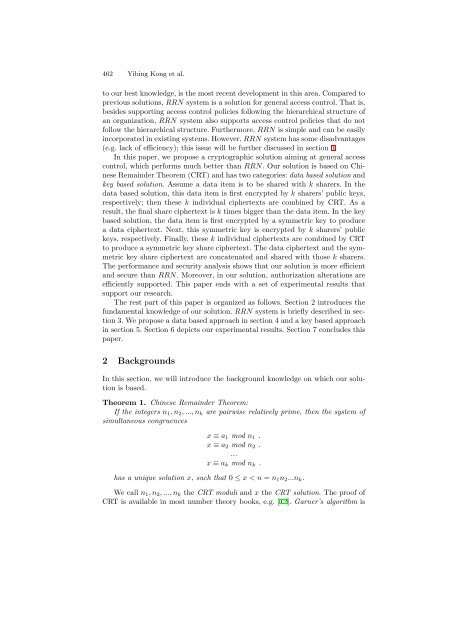A cryptographic solution for general access control - University of ...
A cryptographic solution for general access control - University of ...
A cryptographic solution for general access control - University of ...
- No tags were found...
You also want an ePaper? Increase the reach of your titles
YUMPU automatically turns print PDFs into web optimized ePapers that Google loves.
462 Yibing Kong et al.to our best knowledge, is the most recent development in this area. Compared toprevious <strong>solution</strong>s, RRN system is a <strong>solution</strong> <strong>for</strong> <strong>general</strong> <strong>access</strong> <strong>control</strong>. That is,besides supporting <strong>access</strong> <strong>control</strong> policies following the hierarchical structure <strong>of</strong>an organization, RRN system also supports <strong>access</strong> <strong>control</strong> policies that do notfollow the hierarchical structure. Furthermore, RRN is simple and can be easilyincorporated in existing systems. However, RRN system has some disadvantages(e.g. lack <strong>of</strong> efficiency); this issue will be further discussed in section 3.In this paper, we propose a <strong>cryptographic</strong> <strong>solution</strong> aiming at <strong>general</strong> <strong>access</strong><strong>control</strong>, which per<strong>for</strong>ms much better than RRN. Our <strong>solution</strong> is based on ChineseRemainder Theorem (CRT) and has two categories: data based <strong>solution</strong> andkey based <strong>solution</strong>. Assumeadataitemistobesharedwithk sharers. In thedata based <strong>solution</strong>, this data item is first encrypted by k sharers’ public keys,respectively; then these k individual ciphertexts are combined by CRT. As aresult, the final share ciphertext is k times bigger than the data item. In the keybased <strong>solution</strong>, the data item is first encrypted by a symmetric key to producea data ciphertext. Next, this symmetric key is encrypted by k sharers’ publickeys, respectively. Finally, these k individual ciphertexts are combined by CRTto produce a symmetric key share ciphertext. The data ciphertext and the symmetrickey share ciphertext are concatenated and shared with those k sharers.The per<strong>for</strong>mance and security analysis shows that our <strong>solution</strong> is more efficientand secure than RRN. Moreover, in our <strong>solution</strong>, authorization alterations areefficiently supported. This paper ends with a set <strong>of</strong> experimental results thatsupport our research.The rest part <strong>of</strong> this paper is organized as follows. Section 2 introduces thefundamental knowledge <strong>of</strong> our <strong>solution</strong>. RRN system is briefly described in section3. We propose a data based approach in section 4 and a key based approachin section 5. Section 6 depicts our experimental results. Section 7 concludes thispaper.2 BackgroundsIn this section, we will introduce the background knowledge on which our <strong>solution</strong>is based.Theorem 1. Chinese Remainder Theorem:If the integers n 1 ,n 2 , ..., n k are pairwise relatively prime, then the system <strong>of</strong>simultaneous congruencesx ≡ a 1 mod n 1 .x ≡ a 2 mod n 2 ....x ≡ a k mod n k .has a unique <strong>solution</strong> x, such that 0 ≤ x
















